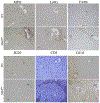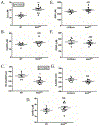Cholestatic liver disease results increased production of reactive aldehydes and an atypical periportal hepatic antioxidant response
- PMID: 31377417
- PMCID: PMC6848778
- DOI: 10.1016/j.freeradbiomed.2019.07.036
Cholestatic liver disease results increased production of reactive aldehydes and an atypical periportal hepatic antioxidant response
Abstract
Cholangiopathies such as primary sclerosing cholangitis (PSC) are chronic liver diseases characterized by increased cholestasis, biliary inflammation and oxidative stress. The objective of this study was to elucidate the impact of cholestatic injury on oxidative stress-related factors. Using hepatic tissue and whole cell liver extracts (LE) isolated from 11-week old C57BL/6J (WT) and Mdr2KO mice, inflammation and oxidative stress was assessed. Concurrently, specific targets of carbonylation were assessed in LE prepared from murine groups as well as from normal and human patients with end-stage PSC. Identified carbonylated proteins were further evaluated using bioinformatics analyses. Picrosirius red staining revealed extensive fibrosis in Mdr2KO liver, and fibrosis colocalized with increased periportal inflammatory cells and both acrolein and 4-HNE staining. Western blot analysis revealed elevated periportal expression of antioxidant proteins Cbr3, GSTμ, Prdx5, TrxR1 and HO-1 but not GCLC, GSTπ or catalase in the Mdr2KO group when compared to WT. From immunohistochemical analysis, increased periportal reactive aldehyde production colocalized with elevated staining of Cbr3, GSTμ and TrxR1 but surprisingly not with Nrf2. Mass spectrometric analysis revealed an increase in carbonylated proteins in the Mdr2KO and PSC groups compared to respective controls. Gene ontology and KEGG pathway analysis of carbonylated proteins revealed a propensity for increased carbonylation of proteins broadly involved in metabolic processes as well more specifically in Rab-mediated signal transduction, lysosomes and the large ribosomal subunit in human PSC. Western blot analysis of Rab-GTPase expression revealed no significant differences in Mdr2KO mice when compared to WT livers. In contrast, PSC tissue exhibited decreased levels of Rabs 4, 5 and increased abundance of Rabs 6 and 9a protein. Results herein reveal that cholestasis induces stage-dependent increases in periportal oxidative stress responses and protein carbonylation, potentially contributing to pathogenesis in Mdr2KO. Furthermore, during early stage cholestasis, there is cell-specific upregulation of some but not all, antioxidant proteins.
Keywords: Cholestasis; Inflammation; Liver; Oxidative stress; Protein carbonylation; Reactive aldehyde.
Copyright © 2019 Elsevier Inc. All rights reserved.
Figures










References
-
- Boonstra K, Beuers U, Ponsioen CY, Epidemiology of primary sclerosing cholangitis and primary biliary cirrhosis: a systematic review, J Hepatol 56(5) (2012) 1181–8. - PubMed
-
- Molodecky NA, Kareemi H, Parab R, Barkema HW, Quan H, Myers RP, Kaplan GG, Incidence of primary sclerosing cholangitis: a systematic review and meta-analysis, Hepatology 53(5) (2011) 1590–9. - PubMed
-
- Pollheimer MJ, Trauner M, Fickert P, Will we ever model PSC? - “it’s hard to be a PSC model!”, Clin Res Hepatol Gastroenterol 35(12) (2011) 792–804. - PubMed
-
- Vendemiale G, Grattagliano I, Lupo L, Memeo V, Altomare E, Hepatic oxidative alterations in patients with extra-hepatic cholestasis. Effect of surgical drainage, J Hepatol 37(5) (2002) 601–5. - PubMed
Publication types
MeSH terms
Substances
Grants and funding
- P30 DK048520/DK/NIDDK NIH HHS/United States
- UL1 RR025780/RR/NCRR NIH HHS/United States
- R21 OD026444/OD/NIH HHS/United States
- P30 CA046934/CA/NCI NIH HHS/United States
- R37 AA009300/AA/NIAAA NIH HHS/United States
- R01 DK123738/DK/NIDDK NIH HHS/United States
- I01 BX002182/BX/BLRD VA/United States
- T32 DK007038/DK/NIDDK NIH HHS/United States
- R01 DK104713/DK/NIDDK NIH HHS/United States
- R01 DK103712/DK/NIDDK NIH HHS/United States
- R01 AA009300/AA/NIAAA NIH HHS/United States
- R56 DK123738/DK/NIDDK NIH HHS/United States
- R37 DK050189/DK/NIDDK NIH HHS/United States
- R01 DK095491/DK/NIDDK NIH HHS/United States
LinkOut - more resources
Full Text Sources
Medical
Research Materials
Miscellaneous

